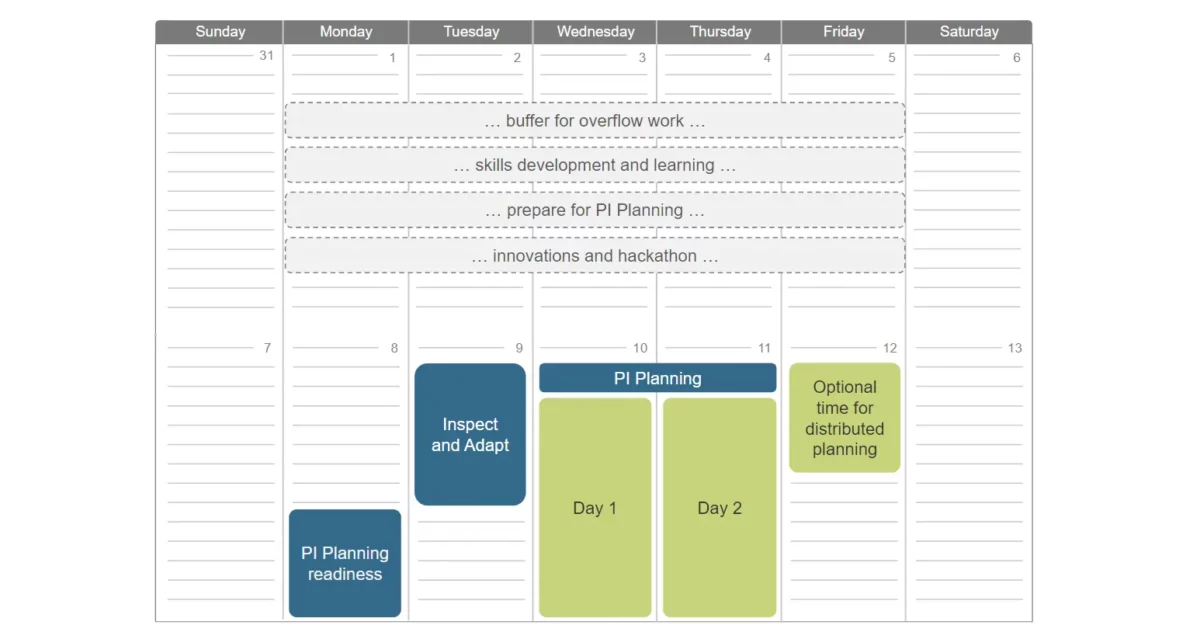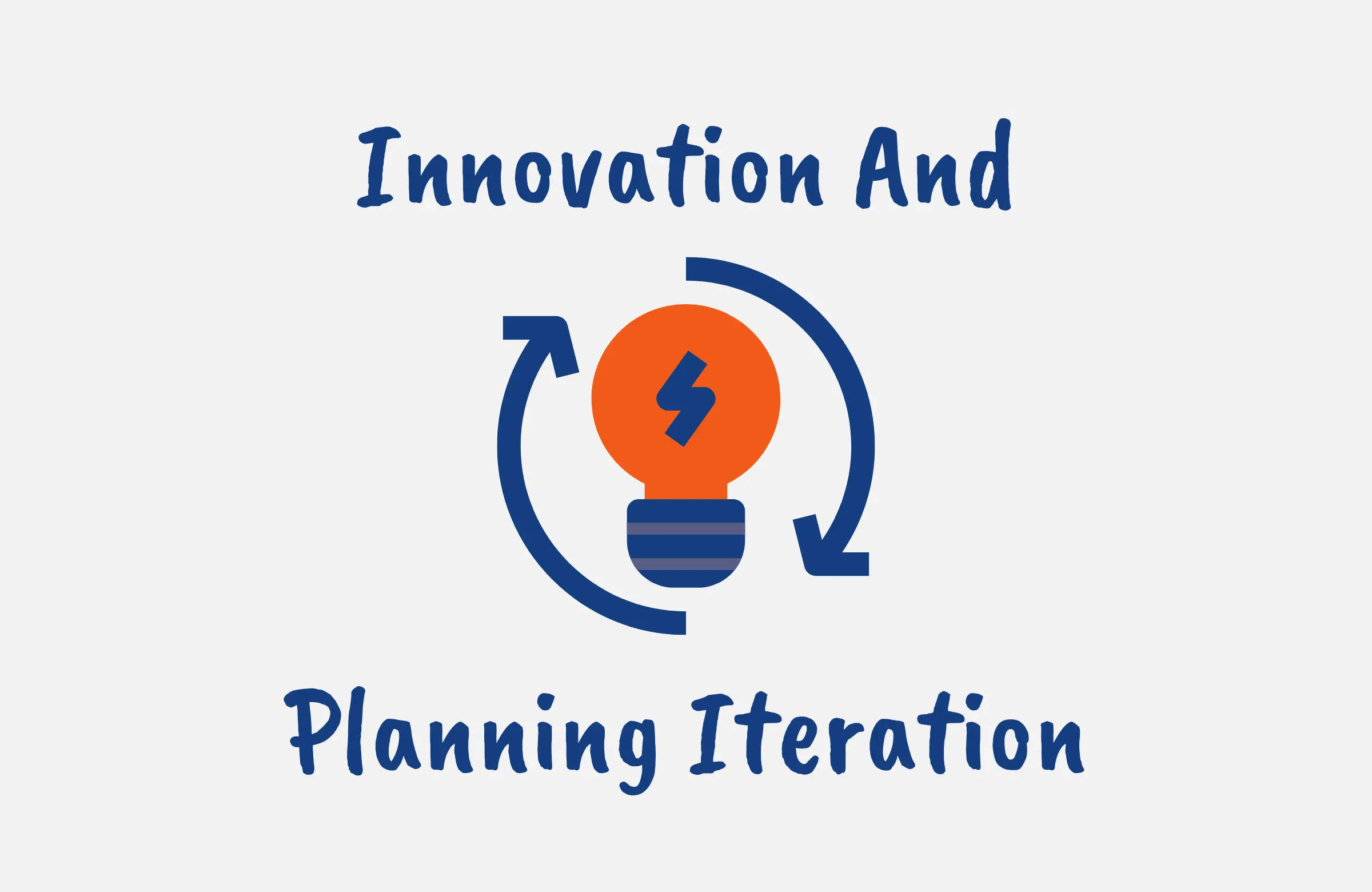Innovation and Planning Iteration in the Scaled Agile Framework (SAFe) is a dedicated iteration that occurs every Program Increment to provide teams time for innovation, continuing education, PI planning, and other events.
The Innovation and Planning Iteration serves an important purpose – giving teams a break from the intense focus on continuous delivery to recharge.
In the article, we’ll provide an overview of what the Innovation and Planning Iteration is about, why it’s valuable, and how your teams can get the most out of this unique opportunity.
What is Innovation and Planning Iteration in SAFe?
The Innovation and Planning (IP) Iteration is a dedicated iteration that occurs at the end of every Program Increment (PI) in SAFe providing teams time for activities that can be difficult to fit into the normal cadence of continuous value delivery.
During the Innovation and Planning Iteration, teams have the opportunity to focus on innovation, continuing education, backlog refinement, and PI planning events like Inspect and Adapt.
It acts as a buffer between PIs, giving teams room to explore new ideas and prepare for the next PI without carrying over unfinished work.
Essentially, the IP Iteration is a valuable part of the PI cadence that offers a chance for Agile teams to “sharpen their tools” and recharge their creativity outside the intensity of delivering new features iteration after iteration.

Purpose of Innovation and Planning (IP) Iteration
The Innovation and Planning (IP) Iteration serves several key purposes including:
Provides Time for Innovation
With the constant focus on delivery during regular PIs, there is little room for innovation. The IP Iteration offers dedicated time for teams to explore new ideas through activities like hackathons.
It lets people work on anything related to the company mission and demo their innovations afterward which fuels creativity and new thinking.
Allows Preparation for PI Planning
The IP Iteration provides time for final backlog refinement before PI Planning such that teams can complete story prioritization and elaboration to maximize the productivity of upcoming planning.
The cadence of the IP Iteration ensures regular time is allotted for this continuous improvement activity.
Enables PI Events
Events like Inspect and Adapt and PI Planning take place during the IP Iteration. This prevents these vital activities from diminishing team velocity during normal PIs focused on feature delivery.
The consistency of the IP Iteration cadence also facilitates planning these events well in advance.
Provides Estimating Buffer
Teams do not take on new features during the IP Iteration, creating a buffer between PIs.
This buffer absorbs unpredictability and prevents teams from carrying unfinished work forward which enhances predictability and the ability to meet PI objectives.
Allows Time for Improvement
The IP Iteration offers time for activities difficult to fit in during feature development like improving infrastructure, addressing technical debt, and enabling continuous learning.
Teams can “sharpen their tools” without taking time from critical feature work.

Innovation and Planning Activities
The Innovation and Planning (IP) Iteration provides dedicated time for teams to work on activities that are difficult to fit into the normal cadence of continuous value delivery.
The IP Iteration allows teams to step back and focus on improving themselves, their processes, and their products in ways that enhance flow, quality, and innovation.
Time for Innovation and Exploration
A major purpose of the IP Iteration is to provide time for innovation beyond the iterations dedicated to ongoing feature delivery. IP Iterations often include research, design, and ideation activities like hackathons.
Hackathons give team members the freedom to explore innovative ideas and collaborate in new ways, unconstrained by the backlogs and team structures of their day-to-day work.
At the end of a hackathon, teams demonstrate their work, and the most promising ideas are captured to inform future backlogs. Hackathons drive real innovation aligned with the organization’s mission.
Addressing Technical Debt and Improving Infrastructure
The IP Iteration offers a valuable opportunity to pay down technical debt, upgrade tools and infrastructure, and remove impediments to flow.
With teams heads-down on feature delivery in regular iterations, it can be difficult to allocate time to major infrastructure changes or migrations. The IP Iteration provides a window to take on this work without disrupting ongoing feature development.
Education, Training, and Communities of Practice
The IP Iteration facilitates continuous learning and growth. New practices and technologies emerge constantly, but few chances exist to develop skills amid the press of feature delivery.
The IP Iteration offers time for training across domains, languages, frameworks, and roles.
ARTs can also launch Communities of Practice to foster ongoing learning around SAFe practices like writing quality user stories, test automation, and product ownership.
The IP Iteration kickstarts these efforts which boost engagement, mastery, and productivity over time.
PI Planning and Inspect and Adapt
Rather than reducing team velocity, the IP Iteration hosts major PI events like Inspect and Adapt workshops and PI Planning.
With cadenced IP Iterations, these events can be reliably scheduled and prepared for, improving their effectiveness.
The timebox also allows last-minute backlog refinement to maximize planning productivity.
Integration and Final Preparations
For hardware and complex systems, the IP Iteration may offer the only practical window for full-system integration.
While continuous end-to-end integration is ideal, the IP Iteration provides a fallback integration point.
Final integration, documentation, and UAT can also be completed.

Benefits of Innovation and Planning (IP) Iteration
The IP Iteration provides significant benefits for teams, leaders, and the broader organization.
By carving out time for learning, improvement, and preparation, the IP Iteration enhances engagement, quality, and flow.
Increased Predictability
The IP Iteration builds in an estimating buffer that prevents teams from overcommitting capacity.
This buffer absorbs unexpected delays and dependencies, increasing predictability and on-time delivery.
Reduced Burnout
The intense focus on continuous delivery can lead to burnout over time. The IP Iteration offers a break in rhythm for teams to explore new ideas and upgrade skills. This time for renewal boosts morale and job satisfaction.
Increased Innovation
Finding time for innovation is difficult with the constant pressure to deliver new features.
The IP Iteration carves out space for ideation and exploration outside normal constraints, leading to innovative thinking.
Advanced Skills and Knowledge
The IP Iteration facilitates training, communities of practice, and cross-functional collaboration.
Team members can develop critical new skills in techniques like automated testing, Agile architecture, and story refinement.
Improved Quality and Flow
With dedicated time to pay down technical debt, upgrade tools, and remove impediments, the IP Iteration enhances quality and flow.
This way, issues get addressed in bulk rather than piecemeal during feature development.
Preparedness for PI Events
Major events like PI Planning and Inspect and Adapt workshops can be optimally prepared for and scheduled during the IP Iteration, improving their productivity.
Reliable Integration Opportunities
For complex systems, the IP Iteration ensures a reliable integration point for end-to-end testing. While continuous integration is preferred, the IP Iteration provides a safety net.

What are Innovation and Planning Iteration Anti-Patterns?
While properly utilized IP Iterations provide immense value, some common anti-patterns can reduce their effectiveness. Avoiding these pitfalls is key to maximizing the benefits of the IP Iteration.
Here are some common Innovation and Planning Iteration anti-patterns:
Using IP Iteration as an Overflow Buffer
The IP Iteration buffer should absorb unpredictable variability, not as an excuse to overload teams and regularly overflow work. Routinely using the IP Iteration to complete unfinished features defeats its purpose.
No Time Allocated for Innovation
Innovation and ideation need protected time. Without deliberate prioritization, innovation often gets crowded out by more urgent work. Set aside a major block of IP Iteration time for new ideas.
No Cadence or Planning
IP Iterations lose impact if they occur sporadically with last-minute planning. Schedule them reliably every PI with enough lead time for teams to prepare and coordinate activities.
No Support for Training
The IP Iteration offers a prime window for skills training and growth. Failing to leverage it results in stale skills and stagnating engagement. Make learning a standing agenda item.
No Exploration of New Technologies
It’s easy for teams to remain heads-down on familiar tools and platforms rather than exploring new tech. Use part of the IP Iteration to spike innovative new technologies.
Separate Team Activities
While some activities will be team-specific, much of the IP Iteration should foster cross-team collaboration. Bring teams together for broad skill development and problem-solving.
Paradigm Lock-In
It’s easy to remain stuck in status quo patterns and processes. Use the IP Iteration for a reflective critique of existing paradigms to unlock innovation.
Uncoordinated Efforts
Maximum benefit comes from coordinating IP Iteration activities across teams. Avoid siloed efforts by collaboratively planning and sharing results across the ART.

What is the Role of the Scrum Master During the Innovation and Planning Iteration?
The Scrum Master plays a pivotal role in ensuring a successful IP Iteration. While teams self-organize activities, the Scrum Master facilitates collaboration, learning, and meaningful outcomes through the following:
Promoting Team-Driven Innovation
The Scrum Master encourages teams to take ownership of innovation by brainstorming ideas for hackathons, spikes, and experiments. They help teams coordinate with other teams to share resources and results.
Facilitating Cross-Training
The Scrum Master identifies skill gaps that could be addressed during the IP Iteration and helps coordinate cross-training sessions. They promote knowledge sharing across teams.
Supporting Technical Improvement
The Scrum Master works with teams to identify the top technical debt items, defects, and impediments to address during the IP Iteration. They shield teams from interruptions to focus on these improvements.
Enabling Continued Learning
The Scrum Master identifies training needs and helps arrange internal or external training on SAFe practices during the IP Iteration. They also foster informal mentoring and communities of practice.
Enabling PI Planning
To prepare for PI Planning, the Scrum Master ensures backlogs are groomed and dependencies mapped, by working with the Product Owner on story elaboration and prioritization based on WSJF.
The Scrum Master also coordinates logistics to set their team up for an efficient planning experience.
Advising on Team Activities
While prescribing solutions reduces team ownership, the Scrum Master serves as an advisor to teams on which activities will offer the most value based on the team’s context and challenges.
Coordinating Across Teams
The Scrum Master collaborates with other Scrum Masters to ensure alignment of IP Iteration activities across teams helping them share resources, synchronize program-level activities, and disseminate results.
Ensuring Time for Reflection
The Scrum Master protects team time for retrospectives and problem-solving workshops during the IP Iteration by encouraging teams to reflect on how to improve their processes and teamwork.
Promoting Team Health
The Scrum Master checks in on team health during the IP Iteration, watching for signs of burnout.
They work to re-energize members and refine ways of working to support engagement and enjoyment as protecting team cohesion, trust, and transparency is critical.
Conclusion
The Innovation and Planning Iteration in SAFe plays a vital role in enabling continuous improvement and learning.
Without dedicated time for innovation, planning, and team rejuvenation, it’s easy for Agile teams to become burned out and stuck in reactive mode.
Leveraging the IP Iteration provides a regular cadence for optimizing processes, exploring new ideas, and setting teams up for success.
Keep the IP Iteration in mind as a valuable tool for fueling engagement and creativity, and delivering increased value.
FAQs
How Often Does the Innovation and Planning Iteration Occur?
The Innovation and Planning (IP) Iteration typically occurs every Program Increment (PI), which is usually 8-12 weeks in SAFe (Scaled Agile Framework).
What Can Occur as a Result of Not Having an Innovation and Planning Iteration?
Without an Innovation and Planning Iteration, teams may face burnout, decreased quality, innovation deficit, planning gaps, and misalignment with long-term goals.





